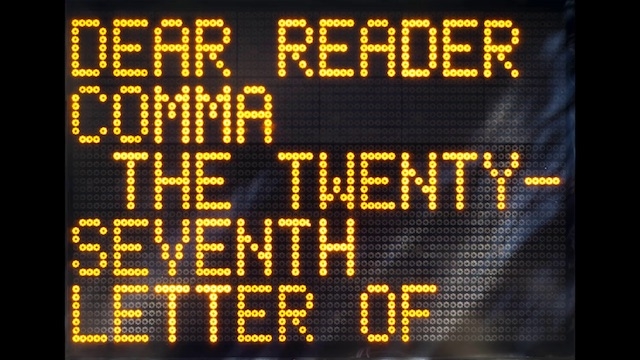Last summer, the story of a failed Facebook experiment went viral: Alice and Bob, two semi-intelligent chatbots instructed to trade objects with each other in order to develop a new negotiation software, were shut down after starting a conversation in a self-generated language (‘balls have zero to me to me to me to me to me to me to me to me to’). The programmers had not instructed the machines to adopt human-only expressions, and the ensuing (temporary) human inability to interpret what was going on on the ‘other side’ was translated by the media into paramount anxiety.
I was reminded of this after entering the new V-A-C Foundation in Venice, funded by Russian energy tycoon Leonid Mikhelson. Shannon Ebner’s video Dear Reader, installed across the entrance, records the flashes of a portable changeable-message sign, programmed by the artist to display her poem ‘The Electric Comma’ (both 2011) – the work lending this group show its title. An elliptical line like ‘the twenty seventh letter of the alphabet is a blank comma delay a language of exposures’ is almost illegible, because of the changing text’s fast pace. In the age of voice commands and AI policing of online content, the question of how language is articulated, and what it suppresses or silences, resonates with new meanings. By ‘hacking’ a sign machine originally designed to safeguard humans by delivering intelligible instructions, Ebner makes room for blanks, glitches, strikes and asterisks, indicating that ‘there is more information elsewhere’ (as she explains in a conversation with Zoe Leonard in BOMB magazine).
Jointly presenting 27 works from the collections of the V-A-C and Kadist foundations (the show’s cocurators), the exhibition focuses on how contemporary art mirrors human encounters with the machinic sublime. Some works are literally based on encounters: in the striking (if much-shown) 16mm film Soft Materials (2004) by Dara Martin, shot in the Artificial Intelligence Lab at the University of Zürich, two naked dancers meet with deep-learning robots. A flesh limb rubs against a metal one, steel fingers run along a smooth arm, resulting in moments of contact, intimacy and erotic tension, where touch is key; our notion of the digital is, after all, rooted in the digitus (finger). In Pedro Neves Marques’s video The Pudic Relation Between Machine and Plant (2016), a Mimosa pudica, a plant that protects itself by briefly folding its leaves when touched, is caressed by a robotic hand that behaves as if equally pudicus (shy). By contrast, The Brute Force – 1997 (2017) by Fabien Giraud and Raphaël Siboni, the second episode of the duo’s ongoing The Unmanned video series, follows the rigid movements of a computer-programmed camera across an empty set, one that reproduces the room where, in May 1997, the IBM Deep Blue computer defeated chess legend Garry Kasparov.
Cheyney Thompson’s gridded Stochastic Process Painting 11 (2014) mimics the structure of the Drunken Walk algorithm, used by investors to predict stock prices, while with Untitled #1, #2 and #3 (all 2007) Piero Golia stages an ironic ballet mécanique where the passage of time is embodied by a water puddle forming on the ground, a constantly revolving broom and a machine that fires clay pigeons against the wall once an hour, suddenly bringing noise, fear and destruction into the space, and possibly hinting at a future when the hunting abilities of robocops may be of global concern. Misting Miner (2016), a vapour sculpture by Alexey Buldakov from the Russian collective Urban Fauna Lab, turns the energy-consuming extraction, or mining, of fluid cryptocurrencies like Ethereum into a more familiar process generating heat, evaporation and condensation. Outside the window, the Giudecca island on the other side of the canal looks on the verge of flooding: in the age of algorithmic capitalism and its impact on climate change, Venice is sinking faster then ever. The line between the metaphorical and the real appears suddenly thin.
The Electric Comma at V-A-C Foundation, Venice, 26 November – 31 March
From the March 2018 issue of ArtReview
